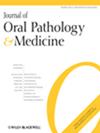Integrity and quantity of salivary cell‐free DNA as a potential molecular biomarker in oral cancer: A preliminary study
IF 2.7
3区 医学
Q1 DENTISTRY, ORAL SURGERY & MEDICINE
引用次数: 11
Abstract
Abstract Background Differences in cell‐free DNA (cfDNA) fragments have been described as a valuable tool to distinguish cancer patients from healthy individuals. We aim to investigate the concentration and integrity of cfDNA fragments in saliva from oral squamous cell carcinoma (OSCC) patients and healthy individuals in order to explore their value as diagnostic biomarkers. Methods Saliva samples were collected from a total of 34 subjects (19 OSCC patients and 15 healthy controls). The total concentration of salivary cfDNA (scfDNA) was determined using a fluorometry method and quantitative real‐time polymerase chain reaction (qPCR). To evaluate the scfDNA quantity and integrity, qPCR targeting Arthobacter luteus (ALU) sequences at three amplicons of different lengths (60, 115, and 247 bp, respectively) was carried out. ScfDNA integrity indexes (ALU115/ALU60 and ALU247/ALU60) were calculated as the ratio between the absolute concentration of the longer amplicons 115 bp and 247 bp and the total scfDNA amount (amplicon 60 bp). Results The total scfDNA concentration (ALU60) was higher in OSCC than in healthy donors, but this trend was not statistically significant. The medians of scfDNA integrity indexes, ALU115/ALU60 and ALU247/ALU60, were significantly higher in OSCC, showing area under the curve values of 0.8211 and 0.7018, respectively. Conclusion Our preliminary results suggest that scfDNA integrity indexes (ALU115/ALU60 and ALU247/ALU60) have potential as noninvasive diagnostic biomarkers for OSCC.唾液无细胞DNA的完整性和数量作为口腔癌潜在的分子生物标志物:初步研究
游离细胞DNA (cfDNA)片段的差异被认为是区分癌症患者和健康个体的一种有价值的工具。我们旨在研究口腔鳞状细胞癌(OSCC)患者和健康人唾液中cfDNA片段的浓度和完整性,以探讨其作为诊断生物标志物的价值。方法采集34例口腔鳞癌患者(19例)和健康对照(15例)的唾液样本。采用荧光法和定量实时聚合酶链反应(qPCR)测定唾液cfDNA (scfDNA)总浓度。为了评估scfDNA的数量和完整性,我们对三个不同长度的扩增片段(分别为60、115和247 bp)进行了qPCR。ScfDNA完整性指数(ALU115/ALU60和ALU247/ALU60)计算为长扩增子115 bp和247 bp的绝对浓度与总ScfDNA量(扩增子60 bp)之比。结果OSCC供者scfDNA总浓度(ALU60)高于健康供者,但差异无统计学意义。scfDNA完整性指数的中位数ALU115/ALU60和ALU247/ALU60在OSCC中显著较高,曲线下面积分别为0.8211和0.7018。结论scfDNA完整性指数(ALU115/ALU60和ALU247/ALU60)有潜力作为OSCC的无创诊断生物标志物。
本文章由计算机程序翻译,如有差异,请以英文原文为准。
求助全文
约1分钟内获得全文
求助全文
来源期刊
CiteScore
5.90
自引率
6.10%
发文量
121
审稿时长
4-8 weeks
期刊介绍:
The aim of the Journal of Oral Pathology & Medicine is to publish manuscripts of high scientific quality representing original clinical, diagnostic or experimental work in oral pathology and oral medicine. Papers advancing the science or practice of these disciplines will be welcomed, especially those which bring new knowledge and observations from the application of techniques within the spheres of light and electron microscopy, tissue and organ culture, immunology, histochemistry and immunocytochemistry, microbiology, genetics and biochemistry.

 求助内容:
求助内容: 应助结果提醒方式:
应助结果提醒方式:


